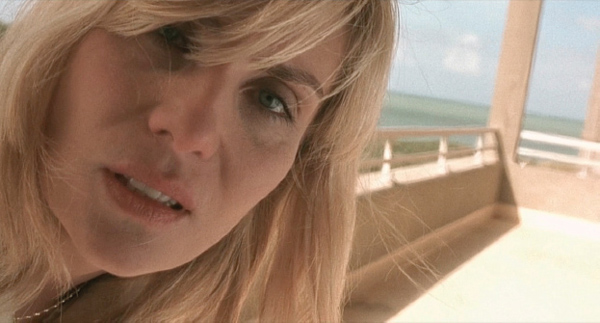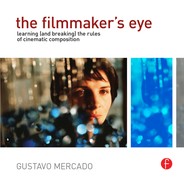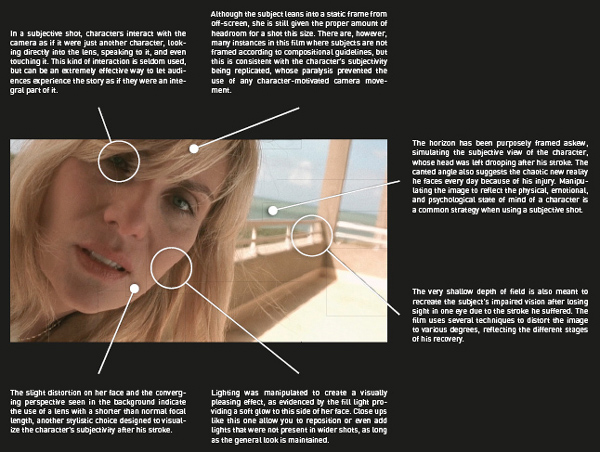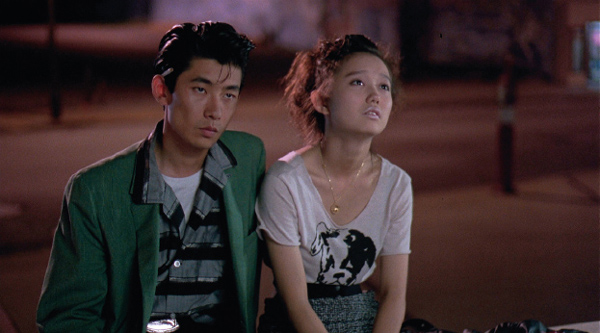subjective shot
The subjective shot is unique in its ability to let audiences experience the action as if seen directly through the eyes of a character. The evolution of cinematic language developed a number of conventions designed to allow audiences to identify with the emotional and/or psychological state of mind of a character (through the use of P.O.V. shots, dream and fantasy sequences, and reaction shots, for instance), but none of them operates by allowing the audience to become a surrogate for a character, watching events unfold as if through their eyes, and making them an intrinsic part of the story for the length of a shot. Subjective shots accomplish this through compositions, staging of the action, and image manipulation designed to mimic the subjective point of view of a given character. The composition of a subjective shot can be carefully manipulated to match both the physical attributes of the character’s perspective, and their emotional and psychological subjectivity. One of the most striking features of the subjective shot is the way it lets the other characters interact directly with the audience, by looking into the lens, speaking to, and sometimes even having physical contact with it. This interaction can be extremely powerful but also potentially very jarring to audiences, who are accustomed to experience the action from the safety of a third person perspective, as invisible and unacknowledged observers. If subjective shots are used for extended periods of time, there is a danger that audiences will find it difficult to identify with the character whose subjectivity they are experiencing, gradually disconnecting with the story. This disconnection is caused by the lack of reaction shots which ordinarily reveal the emotional response of a character. Without the ability to look a character in the eye, audiences are left uncertain as to how they should feel and react to the events they experience, leading to ambiguities that fail to produce a sense of narrative clarity. The subjective shot should therefore only be used under very special circumstances and even then only for short periods of time, particularly when placing the audience in the shoes of a character will amplify the dramatic impact of a scene, or when letting them see the action through the eyes of a character provides them with a unique insight that would not be possible to experience with any other type of shot. The composition and look of the subjective shot will depend on the visual metaphor being used to show a given psychological or physical subjectivity; for instance, what would the subjectivity be of a character who suffered a stroke? What would the world look like through their eyes?
Jonathan Demme uses subjective shots in this way in The Silence of the Lambs (1991), at important moments in the narrative when Clarice Starling (Jodie Foster) has meaningful exchanges with Dr. Hannibal Lecter (Anthony Hopkins) and other key characters. In the example on the left, Lecter is shown unbearably close to her (and the audience), even though it was established he is in fact several feet away in previous shots from the same scene; the subjective shot visualizes just how imposing and menacing he comes across when he incisively forces Clarice to reveal an important childhood memory.
Several key scenes in Jonathan Demme’s The Silence of the Lambs (1991) have characters addressing Clarice Starling (Jodie Foster) by looking directly into the lens. This use of subjective shots allows the audience to feel what it is like to stand face to face with the menacing Dr. Hannibal Lecter (Anthony Hopkins).
subjective shot

why it works
The subjective shot is unique in its ability to let the audience experience action through the perspective of a character. In this type of shot, characters interact with the camera as if it were an individual, looking at, speaking to, and even touching it. The composition of this shot should reflect the angle of view from which the individual would see the action. Focal length, camera movement, composition, and other kinds of image manipulation can also be used to visualize the specific physical, emotional, and psychological attributes belonging to the specific subjectivity of a character. Julian Schnabel’s The Diving Bell and the Butterfly (2007) uses subjective shots throughout most of the film to make the audience experience what life was like for Jean-Do (Mathieu Almaric) after suffering a massive stroke at age 42. The relatively few reaction shots used are complemented with a voice over from his still intact consciousness, letting audiences sympathize with his plight. Shot compositions were designed to simulate the subjectivity of the stroke victim, as seen in this example when his wife Céline (Emmanuelle Seigner) visits him.
technical consideration
lenses
While a normal lens would seem like the obvious choice for a shot that simulates a character’s visual perspective, this is not always the case. Other factors should be considered, like whether the shot will include camera movement (a common subjective shot technique), and what kind of camera movement will be used. For instance, if you want to conceal camera shake, wide angle lenses would be preferable; if the movement will be accomplished with the use of a tracking, dolly, or Steadicam rig, longer focal lengths could also be used. Lenses could also be selected to communicate a specific visual metaphor that might convey the physical, emotional, and/or psychological characteristics of the subjectivity being shown. You could use a tilt-shift lens to simulate the subjectivity of a character with poor eyesight, or a telephoto lens that narrows the field of view to indicate that a character is fixated with a particular object or subject. While some conventions are more established than others (like using a “fish eye” lens to show that someone is under the influence of drugs, or a double exposure to show a character is drunk), remember that every film creates its own visual vocabulary to some extent, so feel free to come up with your own visual metaphor.
format
Subjective shots often include camera movement. Usually, a handheld camera will be used, to differentiate it from the steadiness of a dolly shot and to more closely simulate the movement of a real person (although many films also use tracking and Steadicam rigs for subjective shots). If this is the case, smaller, lighter cameras would be preferable, possibly even mixing formats (for instance, if the shooting format is 35mm, one could shoot the subjective shot sequences in Super 16mm with a slow stock for a 35mm blow up, or even shoot on HD to then upscale the footage to 2K and later transfer to 35mm). The complexity of the camera movement and the requirements of the visual strategy devised to simulate the subjectivity will ultimately dictate the kind of hardware necessary to create the shot; no film exemplifies this better than Aleksandr Sokurov’s Russian Ark (2002), a film shot with an HD camera on a Steadicam rig for its 91-minute single-take subjective sequence shot which travels through the Hermitage museum and 300 years of Russian history (included in the sequence shot chapter).
lighting
If the subjective shot includes camera movement, the placement of lights will have to take this into account; the moving camera creates a dynamic frame that can restrict where lights can be placed without being seen, and in many cases you might not be able to use any conventional movie lights, particularly when shooting night interiors. In these cases, a good strategy is to use practicals (sources of light that are visible within the shot and are part of the art direction for a given location, like table lamps), relamped with higher-wattage bulbs that are commonly connected to dimmer boards to control their output, providing you with enough exposure to shoot. A drawback when using this lighting strategy is that, depending on how much is seen within the shot, you might end up needing quite a few practicals. When shooting day interiors, one option is to light the location using larger fixtures strategically positioned outside windows to provide motivated lighting, freeing the camera to move almost anywhere; you can save yourself a lot of trouble and extra expense by choosing a location that is on the ground level, so that you will not have to rent cranes or extendable platforms to raise lights to a second or third story set of windows. Night exteriors are usually handled by shooting dusk for night, choosing a location that happens to have a lot of available light, or the more expensive route, by using large lighting instruments on platforms or hung from cranes.
breaking the rules

Spike Jonze’s wonderfully surreal Being John Malkovich (1999) uses vignetted subjective shots to visualize what it would be like to experience life through the consciousness (and not simply the perspective) of John H. Malkovich (John G. Malkovich) after a hidden portal to his mind is discovered behind a file cabinet. In this shot, a bewildered Malkovich is seduced by Maxine (Catherine Keener) while Lotte (Cameron Diaz) experiences the action from inside the portal. This particular use of the subjective shot is unique because it lets the audience experience the action through not one, but two subjectivities simultaneously, since we hear Lotte’s voice over at the same time we hear Malkovich’s voice. The physical interaction between the characters was achieved through the use of an ingenious camera rig worn by the director of photography.
Mystery Train. Jim Jarmusch, 1989.


